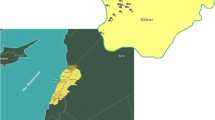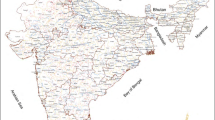Abstract
The presence of organic compounds in drinking water is well recognized in many developing countries; however, the occurrence of organic contaminants in the groundwater of Saudi Arabia, which is the main source of drinking water in the country, is not well documented. A national comprehensive study was carried out to assess the occurrence of organic compounds in groundwater wells used for drinking water purpose, in different regions of Saudi Arabia. A total of 993 well water samples were collected from all 13 administrative regions of the kingdom. Samples were analyzed for a total of 131 organic compounds using the standard methods. The results indicated that total organic carbon values were in the range of 0.01 to 84.13 mg/L with an average weighted value of 12.61 mg/L. Organic compounds were detected in only 9 regions, with 19.84% of the samples containing organic compounds. Only 96 wells (9.67%) showed contents of organic compounds above the safe limits. Pesticides were not detected in any of the well water samples. Overall, organic compounds were found in only 197 out of 993 wells (19.84%) in the whole country. Most of the wells containing organic compounds were located in residential, industrial, and agriculture areas. Riyadh region and Eastern Province were found to have the most affected wells as compared to other regions. Several regions did not show any organic compounds in the well waters.
It can be said that the problem of groundwater contamination with organic compounds in Saudi Arabia is not acute and is manageable at present. It is, however, recommended that a regular monitoring of drinking water wells of all regions should be carried out by the competent authorities for organic compounds to know any contamination if and when it happens. Preventing such contaminants from reaching drinking water sources and protecting drinking water well heads from such contaminants remains a priority.




Similar content being viewed by others
References
Abdulrazzak, M. J., & Khan, M. Z. A. (1990). Domestic water conservation potential in Saudi Arabia. Environmental Management, 14, 167–178.
Al-Ibrahim, A. A. (1992). Excessive use of groundwater resources in Saudi Arabia: impacts and policy options. Ambio, 20, 34–37.
Al-Zahrani, K. H., & Baig, M. B. (2011). Water in the Kingdom of Saudi Arabia: sustainable management options. Journal of Animal and Plant Sciences, 21, 601–603.
Al-Shayaa, M. S. (2011). Some of pesticide application by the farmers and their safety in Alqazalh, Hail area in the Kingdom of Saudi Arabia. Journal of Agricultural and Veterinary Sciences, 4, 55–82.
Al- Wabel, M. I., El- Saeid, M. H., Al- Turki, M., & Abdel- Nasser, G. (2011). Monitoring of pesticide residues in Saudi Arabia agricultural soils. Research Journal of Environmental Sciences, 5, 269–278.
Bob, M., Abd Rahman, N., Taher, S., & Elamin, A. (2013). Multi-objective assessment of groundwater quality in Madinah City, Saudi Arabia. Water Quality Exposure and Health, 7, 53–66.
Bu, Q., Wang, D., Wang, Z., & Gu, J. (2014). Identification and ranking of the risky organic contaminants in the source water of the Danjiangkou reservoir. Frontiers of Environmental Science & Engineering, 8(1), 42–53.
Chen, L., Jin, S., Liu, Y., & Liu, F. (2014). Presence of semi-volatile organic contaminants in shallow groundwater of selected regions in China. Groundwater Monitoring & Remediation, 34(4), 33–43.
Chowdhury, S., & Al-Zahrani, M. (2015). Characterizing water resources and trends of sector wise water consumptions in Saudi Arabia. Journal of King Saud University – Engineering Sciences., 27, 68–82.
Colin, A., Bach, C., Rosin, C., Munoz, J.-F., & Dauchy, X. (2014). Is drinking water a major route of human exposure to alkylphenol and bisphenol contaminants in France? Archives of Environmental Contamination and Toxicology, 66, 86–99.
Dawson, B. J. M., & Belitz, K. (2012). Groundwater quality in the Mojave Area, California, U.S. Geological Survey and the California State Water Resources Control Board. Fact Sheet, 2012-3036, 4.
Di Lorenzo, T., Borgoni, R., Ambrosini, R., Cifoni, M., Galassi, D. M. P., & Petitta, M. (2015). Occurrence of volatile organic compounds in shallow alluvial aquifers of a Mediterranean region: baseline scenario and ecological implications. Science of the Total Environment, 538, 712–723.
Drollette, B. D., Hoelzer, K., Warner, N. R., Darrah, T. H., Karatum, O., O’Connor, M. P., Nelson, R. K., Fernandez, L. A., Reddy, C. M., Vengosh, A., Jackson, R. B., Elsner, M., & Plata, D. L. (2019). Elevated levels of diesel range organic compounds in groundwater near Marcellus gas operations are derived from surface activities. PNAS, 112, 13184–13189.
El-Saeid, M. H., Al-Turki, A. M., Al-Wable, M. I., & Abdel-Nasser, G. (2011). Evaluation of pesticide residues in Saudi Arabia ground water. Research Journal of Environmental Sciences, 5, 171–178.
FAO, Food and Agriculture Organization of the United Nation. (2009). Groundwater management in Saudi Arabia. Rome: Food and Agriculture Organization of the United Nations.
Fayad, N. M., & Tawabini, B. S. (1991). Survey of Saudi Arabian drinking water for trihalomethanes. Bulletin of Environmental Contamination and Toxicology, 46, 305–312.
Frenken, K. (2009). Irrigation in the Middle East region in figures. AQUASTAT Survey – 2008. Food and Agriculture Organization of the United Nation, FAO Water Reports, 34. http://www.fao.org/3/a-i0936e.pdf. Accessed 16 April 2018.
Friesel, P. (1987). Vulnerability of groundwater in relation to subsurface behavior of organic pollutants. In: Van Duijvenbooden, W., and Van Waegeningh, H.G. (Eds.), Vulnerability of soil and groundwater to pollutants. Proceedings International Conference. April 1987. TNO Committee on Hydrological Research, No. 38, 729–740.
Hassan, Y.A.A. (2005). Detection of some pesticide residues in dam sand well waters in Jazan area. Thesis submitted to the King Saud University for the award of Ph.D. degree, Riyadh.
Jurado, A., Walther, M., & Diaz-Cruz, M. S. (2019). Occurrence, fate and environmental risk assessment of the organic microcontaminants included in the watch lists set by EU Decisions 2015/495 and 2018/840 in the groundwater of Spain. Science of the Total Environment, 663, 285–296.
Kennicutt, M. C., & Comet, P. A. (1992). Research of sediment hydrocarbon sources: multiparameter approaches. In J. K. Whelan & J. W. Farrington (Eds.), Organic matter: productivity, accumulation, and preservation in recent and ancient sediments (pp. 308–338). New York: Columbia University Press.
Kerndorff, H., Schleyer, R., Milde, G., & Plumb, R. H. (1992). Geochemistry of groundwater pollutants at German waste disposal sites. In S. Lesage & R. E. Jackson (Eds.), Groundwater contamination and analysis at hazardous waste sites (pp. 245–272). New York: Marcel Dekker Inc.
Lapworth, D. J., Baran, N., Stuart, M. E., Manamsa, K., & Talbot, J. (2015). Persistent and emerging micro-organic contaminants in Chalk groundwater of England and France. Environmental Pollution, 203, 214–225.
Le Dreau, Y., Jacquot, F., Doumenq, P., Guiliano, M., Bertrand, J. C., & Mille, G. (1997). Hydrocarbon balance of a site which had been highly and chronically contaminated by petroleum wastes of a refinery (from 1956 to 1992). Marine Pollution Bulletin, 34, 456–468.
Loos, R., Tavazzi, S., Mariani, G., Suurkuusk, G., Paracchini, B., & Umlauf, G. (2017). Analysis of emerging organic contaminants in water, fish and suspended particulate matter (SPM) in the Joint Danube Survey using solid-phase extraction followed by UHPLC-MS-MS and GC–MS analysis. Science of the Total Environment, 607-608, 1201–1212.
Manamsa, K. E. C., Stuart, M., Talbot, J., Lapworth, D., & Hart, A. (2016). A national-scale assessment of micro-organic contaminants in groundwater of England and Wales. Science of the Total Environment, 568, 712–726.
Padilla, I., Irizarry, C., & Steele, K. (2011). Historical contamination of groundwater resources in the north coast karst aquifer of Puerto Rico. Review Dimensions, 3, 7–12.
Postigo, C., & Barceló, D. (2015). Synthetic organic compounds and their transformation products in groundwater: occurrence, fate and mitigation. Science of the Total Environment, 503-504, 32–47.
Rivera, V. L., Padilla, I. Y., & Torres, N. I. (2017). Spatiotemporal assessment of CVOC contamination in karst groundwater sources and exposure at tap water point of use. In W. White, J. Herman, E. Herman, & M. Rutigliano (Eds.), Karst groundwater contamination and public health (pp. 231–235). Cham: Springer.
Schaider, L. A., Ackerman, J. M., & Rudel, R. A. (2016). Septic systems as sources of organic wastewater compounds in domestic drinking water wells in a shallow sand and gravel aquifer. Science of the Total Environment, 547, 470–481.
Shraim, A. M., Alsuhaimi, A. O., Al-Muzaini, K. O., Kudri, K., & Al-Ameen, H. (2013). Quality assessment of groundwater of Almadinah Almunawarah city. Global NEST Journal, 15(3), 374–383.
Solomons, T., & Fryhle, C. (2004). Organic chemistry (8th ed.). New York: John Wiley & Sons Inc.
SWCC, Saline Water Conversion Corporation, (2015). Saline water conversion corporation annual report. Riyadh, Saudi Arabia.
UN-ESCWA and BGR. (2013) United Nations Economic and Social Commission for Western Asia; Bundesanstalt für Geowissenschaften und Rohstoffe. Inventory of Shared Water Resources in Western Asia. Beirut. https://waterinventory.org/sites/waterinventory.org/files/00-inventory-of-shared-water-resources-in-western-asia-web.pdf. Accessed 17 February 2019.
USEPA, U.S. Environmental Protection Agency. (2012). Drinking water regulations and health advisories. Washington: EPA 822-S-12-001 https://nepis.epa.gov/Exe/ZyPDF.cgi/P100N01H.PDF?Dockey=P100N01H.PDF. Accessed 16 April 2018.
USGS, U. S. G. S. (2006). Volatile organic compounds in the nation’s ground water and drinking-water supply wells. Virginia: Reston https://pubs.usgs.gov/circ/circ1292/pdf/circular1292.pdf. Accessed 17 February 2019.
WHO, World Health Organization. (2011). Guidelines for drinking-water quality (4th ed.). Geneva: World Health Organization.
Yu, X., Ghasemizadeh, R., Padilla, I., Irizarry, C., Kaeli, D., & Alshawabkeh, A. (2015). Spatiotemporal changes of CVOC concentrations in karst aquifers: analysis of three decades of data from Puerto Rico. Science of the Total Environment, 511, 1–10.
Acknowledgments
The authors thank King Abdulaziz City for Science and Technology (KACST) for providing funds and laboratory facilities for carrying out this study under research grant number ARP-30-450. Thanks are also extended to all the technicians and researchers at National Center for Water Technology (NCWT) for their help in sample collection and analysis.
Author information
Authors and Affiliations
Corresponding author
Additional information
Publisher’s note
Springer Nature remains neutral with regard to jurisdictional claims in published maps and institutional affiliations.
Rights and permissions
About this article
Cite this article
Alquwaizany, A.S., Alfadul, S.M., Khan, M.A. et al. Occurrence of organic compounds in groundwater of Saudi Arabia. Environ Monit Assess 191, 601 (2019). https://doi.org/10.1007/s10661-019-7723-6
Received:
Accepted:
Published:
DOI: https://doi.org/10.1007/s10661-019-7723-6




